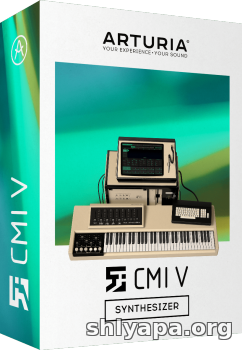Arturia CMI V v1.4.0.2695 CSE

V.R | 04.2019 | 258 MB
The CMI V is a spot-on reincarnation of the first commercially available digital sampling system in music history—the sonic powerhouse behind numerous early MTV-era megahits. We even went the extra mile and added new creative features that weren’t possible back in the day.
In 1980, the Fairlight CMI turned heads with the introduction of digital sampling. Now our software homage lets you turn some heads yourself.
With exotic new sound of digital samples, the promise of an all-in-one digital workstation, and a physical design right out of a sci-fi movie, the Fairlight CMI was an object of desire for most self-respecting ‘80s keyboardists. Countless musicians and producers weighed the risks of bank robbery in order to afford one. No need today. Our faithful recreation gives you the same tools that many MTV stars used to make a cannonball splash into the pool. We’ve even made lots of improvements and additions that bring added power to this keyboard legend, including an alternate additive synthesis engine and tons of new modulation options. No vintage keyboard collection is complete without the CMI V.
Now it’s your turn to experience the sound and power of the digital workstation that started it all.
The unique musical architecture of the CMI
The CMI V isn’t just a digital instrument. It’s a complete digital workstation.
Our enhanced reproduction of this keyboard superhero lets you work with 10 digital instruments of your choice at once—mixing, layering, splitting and sequencing them as you please. Each instrument can draw from three different means of sound generation. The most obvious is the sampling engine that literally first defined the term in the industry. You can also shape sounds with the original additive synthesis engine where you control each of the component harmonics over time. We’ve even spun up the propellers and introduced a newer, simpler means of exploring additive synthesis like you’ve never heard it before named Spectral Synth. You also get around 300 expertly designed presets to get you going—including the original library of sounds you’ll recognize from countless hit recordings.
The CMI V has everything you need to explore the intersection of sampling and digital synthesis.
The original digital sound design powerhouse
If you want to sculpt sounds in the digital domain, the CMI V brings you a complete artists toolbox.
There are a zillion ways to shape sounds with the CMI. Work with a sample from the included library, or load in one of your own. Set the start and end points for the sample and loop. Modify the resolution to juice some interesting side effects. Resynthesize the sample into the additive synth domain for a harmonic representation. Create custom envelopes to control how each harmonic behaves over time. Change the sine waves that make up those harmonics to more complex waveshapes. Add multiple custom modulations to just about any sonic parameters you can think of. Heck, turn those modified additive harmonics back into a sample and sculpt your sound more back in that domain.
The CMI V gives you limitless creative options and sonic variety that are completely unique to this legendary sound design workstation.
The sound heard around the world
Many cutting edge ‘80s songs were fueled by the equally cutting edge sounds of the CMI. Now you can relive the glory days of MTV.
You know the sound of the CMI because it was everywhere—and still is. Consider the ear candy on Kate Bush’s “Running Up That Hill”. The rhythmic frenzy of Herbie Hancock’s “Rockit”. Peter Gabriel’s exotic “Sledgehammer” shakuhachi. The impossible horn line on Yes’ “Owner of a Lonely Heart”. The breathy vocal-flute on Tears for Fears’ “Shout” and “Everybody Wants to Rule the World”. Trevor Horn’s pulsing Page R bottom-end collage on “Relax” by Frankie Goes to Hollywood. Speaking of Hollywood, there’s Duran Duran’s “View to a Kill” Bond theme. How about Jan Hammer’s pitch-processed drums on his weekly “Miama Vice” TV scores? And MTV favs like “Close (to the Edit)” by Art of Noise and Yello’s “Oh, Yeah” are poster children for all things CMI.
Whether for cover-gig authenticity or just basking in nostalgia, CMI V delivers the fun novelty of songs that still fill the classic rock airwaves.
Main Features:
Software synthesizer playable through a MIDI keyboard
600 presets from the original CMI library
360 presets sounds made by Arturia sound designers
Expanded number of track to 10 with a polyphony per track up to 32
Perfect emulation of the analog filter response
Faithful recreation of the sampling and additive synthesis capacities of the instrument
Variable Bit Depth and Sample Rate
Introduction of a new sound generation mode: Spectral synthesis
Classic "page-R" inspired 32-step sequencer
24 sources of modulations per track to apply to all "CONTROL" parameters
High-quality output effects
VST, VST3, AU, AAX, and standalone operation
V 1.4.0
New features
Sliders now hold the mouse position to avoid drag limitations due to screen bounds
When editing a control, the value is now showed next to it and lower bar shows parameter description
Tutorials added on the instruments
Advanced search allowing to quickly access several categories such as instrument, bank, or even preset comments
It is now possible to play the instruments from a computer keyboard in standalone mode
Added keyboard shortcuts to resize the plugins window
New shuffle feature to avoid browsing presets in the same order each time
Reworked playlists workflow, presets are now copied in playlists to avoid unwanted preset modifications
Added “new preset” entry in instruments menu to start a sound from scratch
Reworked audio / MIDI settings window, including standalone BPM parameter
Drop of 32 bits support
Bugfixes
Changing the name of a user preset doesn’t create a copy anymore
No more crashes when selecting ASIO DirectX Full Duplex Driver in standalone on Windows
No more crashes in Juce based hosts when resizing the plugins window
Reduced Fiber Local Storage consumption on Windows
(Win64; AAX, VST3, VST, SAL)
Home page
CLiCK HERE FOR DOWNLOAD

